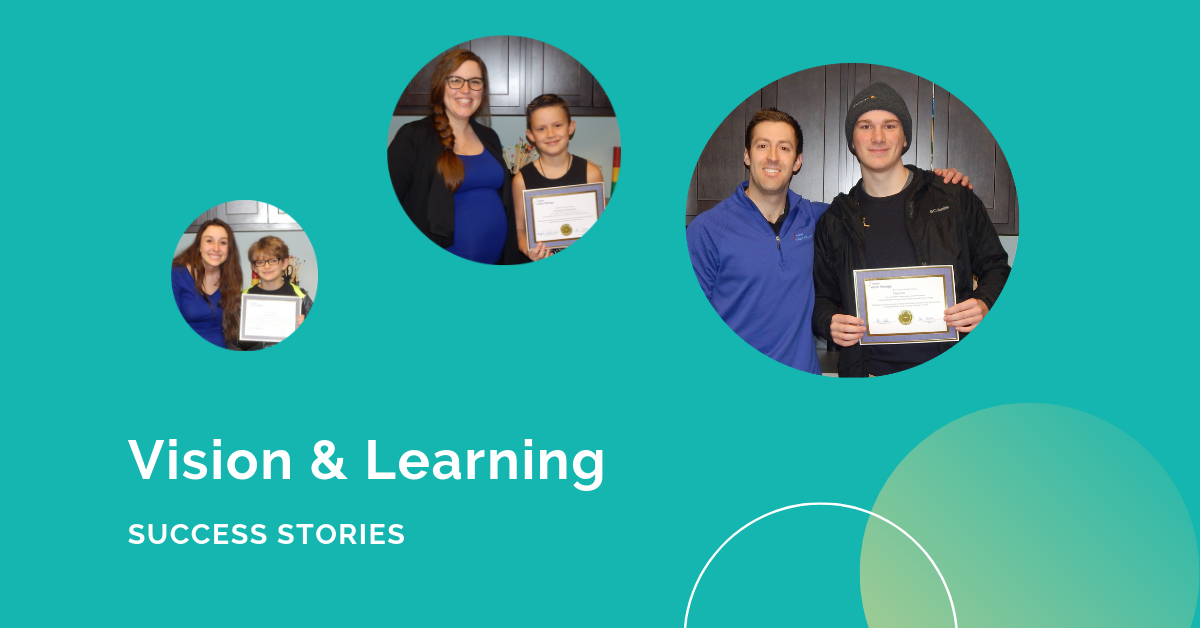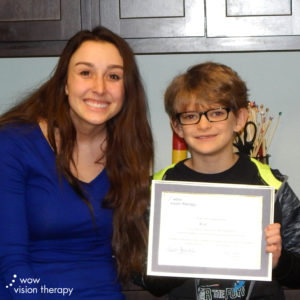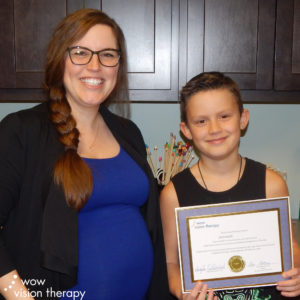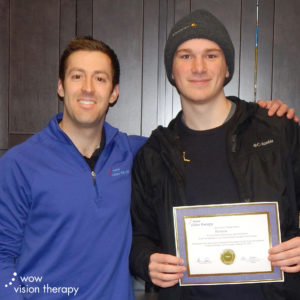Wow Vision Therapy Blog
Let’s Talk Vision Therapy & Academic Success

When you hear “Vision Therapy,” you may not think this type of treatment will increase a student’s academic success. When a child struggles in school, often the last doctor a parent thinks to visit is their optometrist. But, did you know that 80% of learned information is processed through the visual system? Well, you probably are not too surprised by this statistic, right. In school, we read, write, and copy information through our visual system. So obviously a large portion of learning is done visually. But you already knew that, so let me tell you something that may be a bit more surprising.
What if I told you that 1 out of 10 children in the U.S. has a vision problem significant enough to impact reading and learning. Which roughly translates to 5 million affected children in the U.S. alone. But wait! So many people wear glasses or use contacts, so this information can’t be surprising either. Well, here’s the catch. I’m not talking about the need for glasses or contacts. No. I’m talking about all the other vision conditions that impact reading and learning. Just because someone has 20/20 eyesight doesn’t mean they have the visual skills needed to read and learn with accuracy and efficiency. A child may already have the proper prescription for glasses or contacts and still struggle with a vision condition.
So, if we’re not talking about glasses and contacts, what are we talking about? Well, if you feel like I threw a curve ball at you. Don’t worry. I’ll explain what we’re talking about here. But first, lets hit you with some more information.
Did you know that children with a vision-related reading and learning problem are often misdiagnosed with ADD/ADHD? Yup, you heard that right. Not only do these vision conditions affect reading and learning, but they also impact a child’s behavior. Like, a lot. But how is that so? Well, imagine you are back in middle school, and the teacher has asked the class to quietly take notes from the next chapter you are to learn. You open your textbook, gather your notebook and pencil, and get ready to take down all the essential information. As you start reading the first paragraph, you skip lines and have to go back to reread the information. Because you are skipping lines and rereading information, this slows you down to the point where you notice other classmates are way ahead of you. But you keep pushing. And before you know it, the class is over, and most of the students are done with the assignment while you haven’t even got halfway through the chapter. Leaving the class, you feel frustrated and discouraged because now you have more homework to do.
Now, you might think, “No big deal, that happens to everyone now and again.” True. But children with these visual problems struggle daily. And the problem is not necessarily because they skip lines while reading. Children with these vision problems commonly have double vision, struggle with visual tracking, and/or eye focusing. They may have vision loss in one eye or struggle with visual processing. And when a child struggles with all of this during reading and learning, they may ignore their work. Spend time doing other activities that are easier, or show signs of ADHD behavior. Whatsmore, parents are often unaware that their child’s problems in school are related to their vision. With all of that said, let’s finally dive into these visual conditions I’m talking about.
The Conditions
The most common vision conditions that affect reading and learning are:
-
- Accommodative Dysfunction
- Amblyopia “Lazy Eye”
- Convergence Insufficiency
- Oculomotor Dysfunction
- Post-Concussion Vision Syndrome
- Visual Processing Disorder
Students with a vision-related learning problem typically show signs of:
-
- Eye discomfort
- Motion sickness
- Headaches
- Double vision
- Poor tracking
- Visual confusion
- Head tilting
- Problems with math
- Clumsiness
- Poor reading abilities
- Poor attention and concentration
- Poor handwriting skills
- Skipping lines while reading
- Closing an eye while reading
- Letter or number reversals
- Slow at completing tasks
What To Do
So if any of this sounds relatable to you or a child you know, the first step should be to visit a developmental optometrist. From there, they can determine if the problem is visual.
If there are vision-related reading and learning problems present, they are likely to prescribe vision therapy. And after treating the vision problem, success and achievement follow. These improvements are often in:
-
- Academic performance
- Reading and handwriting
- Visual memory
- Work performance
- Attention and concentration
- Confidence
- Sports
Don’t believe me? Check out what some of our past patients have to say about vision therapy.
Success Stories
By: Kristin
In August of 2018, we brought our 8-year-old in for an eye doctor appointment, thinking he “might” need reading glasses. Instead, the doctor told us he couldn’t really help us without prescribing him a strong prescription bifocal. He sent us to Wow Vision Therapy.

In our initial visits, we learned that Ryan was seeing double as far as 14 inches away, words were blurry and jumping around, and his letter reversals might be attributed to his eye problems.
While he admitted that it was hard work, Ryan always enjoyed his appointments with Lauren, and we saw improvements as he learned to adjust his focus.
Now, Ryan is reading and writing much better, and we are excited to try bigger and more challenging books!
By: Rebecca
Before vision therapy, my son struggled with many aspects of life and schoolwork, especially reading and motion sickness. He also had many struggles related to sensory processing, and his nervous system was always in a “burnt out state.” He acted like he never got any rest.
After years of tests, doctors, and other therapy, we reached a point where he was comfortable, but the reading was my biggest “red flag” that something was still off. He could read words at a distance, but even the simplest words seemed to disappear when he would attempt to read a full page.

When we were referred to Wow Vision Therapy and met Dr. B, she let me look through a lens that enabled me to see as Jer did – I was so emotional! I immediately knew that this is what we’d been missing.
About 10 sessions in we noticed dramatic changes. Jer had no more car sickness, and his reading level advanced 2 full grade levels in 3 months.
I’m proud of my son’s hard work! And so grateful to Dr. B and Angela pouring into my son, surrounding him with support, and changing his life!
By: Harrison
Before I began vision therapy, I would struggle to do homework for more than an hour without getting a severe headache. I would especially get tired quickly after reading, as I could only read for around 15 minutes without stopping.
After a few months of vision therapy, it was like I had a different pair of eyes! I had no difficulty focusing on a particular task for an extended period of time, and I could read Crime & Punishment as if it was a kid’s book.
I can definitively say that Wow Vision Therapy made a night and day difference with my vision.
Disclaimer: The patient, parent or guardian in these stories authorized the use and disclosure of the patient’s name, photographic/video images, diagnosis, prognosis, treatment plan, and/or patient testimonial.
 Oliver Fortenbacher
Oliver Fortenbacher
Director of Marketing & Communications
Wow Vision Therapy
GET IN TOUCH
Concerned you or your child may be struggling with a vision problem and wish to learn more about vision therapy? Please fill out the form below and one of our Patient Care Coordinators will be in touch to answer your questions or help schedule an evaluation for you.
